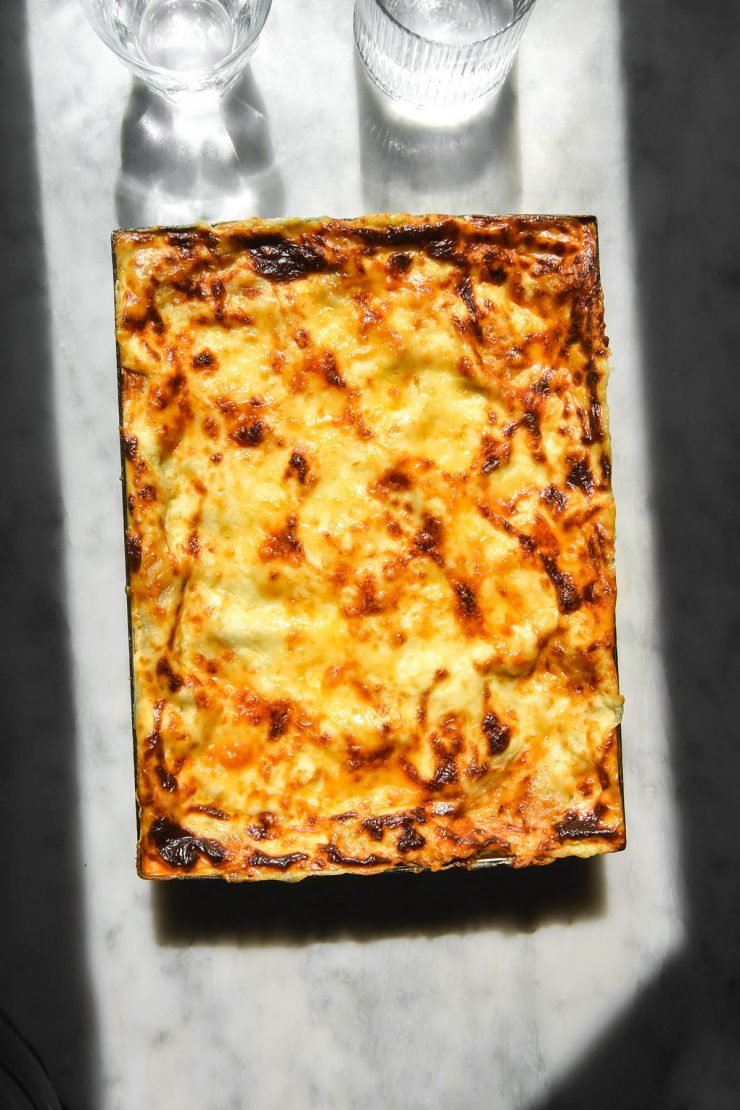
I recently developed 100% buckwheat flour lasagne sheets (egg free) and gluten free wonton wrappers (with eggs). This got me thinking of these gluten free lasagne sheets. They use a combination of both methods and ideas in the aforementioned recipes to create simple homemade lasagne sheets. The sheets are xanthan gum free and easy to roll out without a pasta machine.

Gluten free lasagne sheets (n0 xanthan gum)
I have been developing gluten free recipes for over a decade now. In that time, I have noticed gluten free lasagne sheets are severely lacking. First off, they’re expensive! Most lasagne recipes require two boxes, so we’re looking at $10-15 (Australian) dollars before we event start.
Secondly, they’re not very good! The sheets are made mostly of starches and corn and they curl up as soon as the lasagne hits the oven. I have wasted so much time trying to engineer lasagne so that there’s enough weight on the sheets to keep them from curling up. No more, I say.
These lasagne sheets are made with white rice flour and tapioca flour. They use psyllium husk and some boiling water as a binder. After the water has cooled, the eggs are added to create a smooth dough that is easy to work with.
The sheets require a little bit of rolling out time, but nothing excessive. They’re cheap to make, don’t curl up in the oven and have a majority wholegrain flour ratio. Perfect.
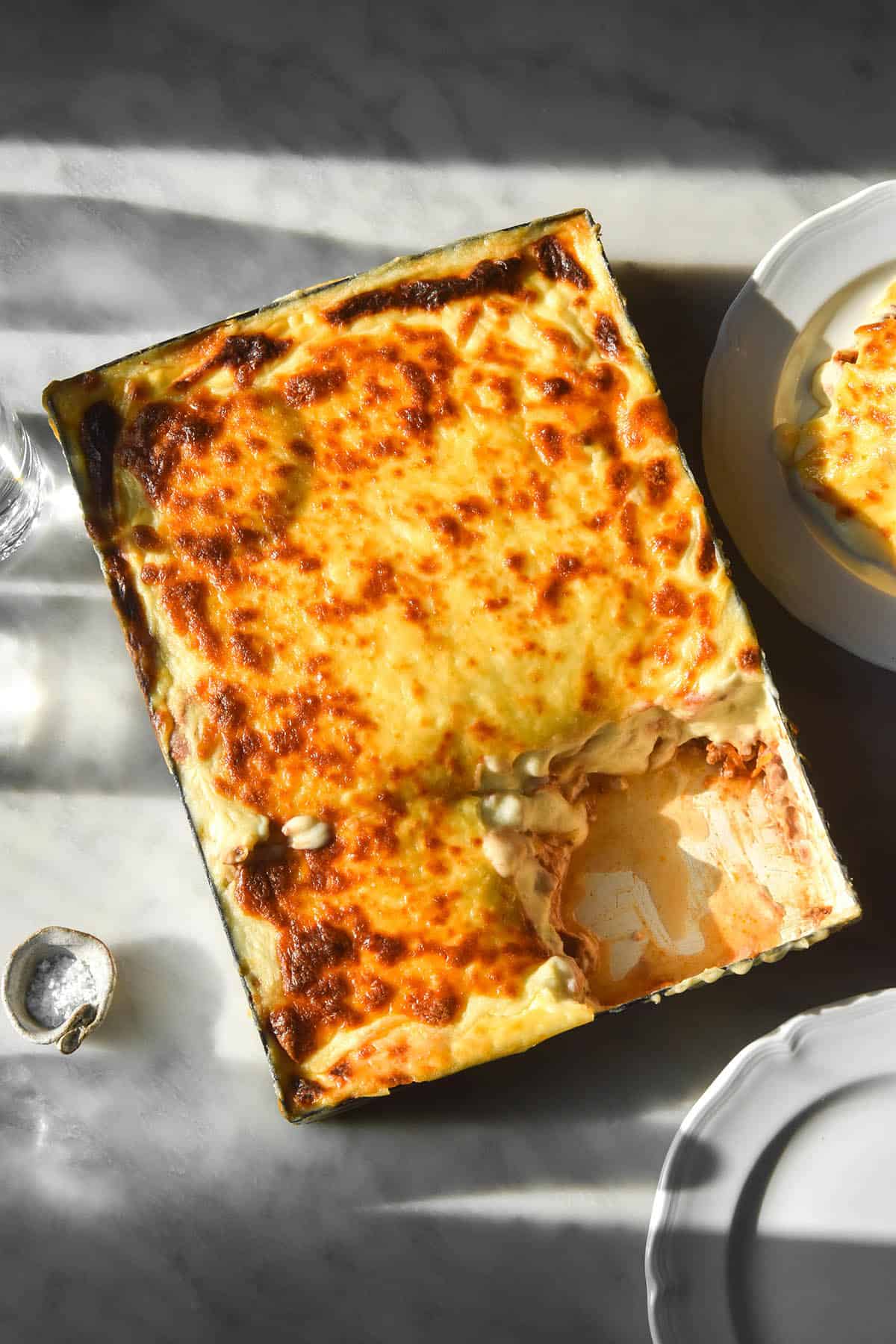
Can I make these gluten free lasagne sheets without eggs?
I haven’t tested this specific recipe without eggs. However, I do have a recipe for 100% buckwheat flour lasagne sheets in my second buckwheat flour e-book. They are gluten free, vegan and xanthan gum free.
Ingredient notes for your gluten free lasagne sheets
I have chosen white rice flour and a small amount of tapioca flour for this recipe. These two flours combined are a good substitute for a neutral, wheat like taste and appearance. They are also easier to find and less expensive than some other gluten free flours. I haven’t tested an alternative for this combination or any other flours.
If you’d like to experiment, go for it! But I cannot guarantee the results. I would recommend adding water or eggs conservatively if you attempt a rice flour free version, as rice flour is more absorbent than other gluten free flours.
There is no substitute for psyllium husk powder here. It binds the dough together and absorbs enough liquid to create pliable sheets. I personally buy the flakes and grind them to a powder in a spice grinder. Store bought psyllium husk powder can sometimes turn a purple or grey once baked.
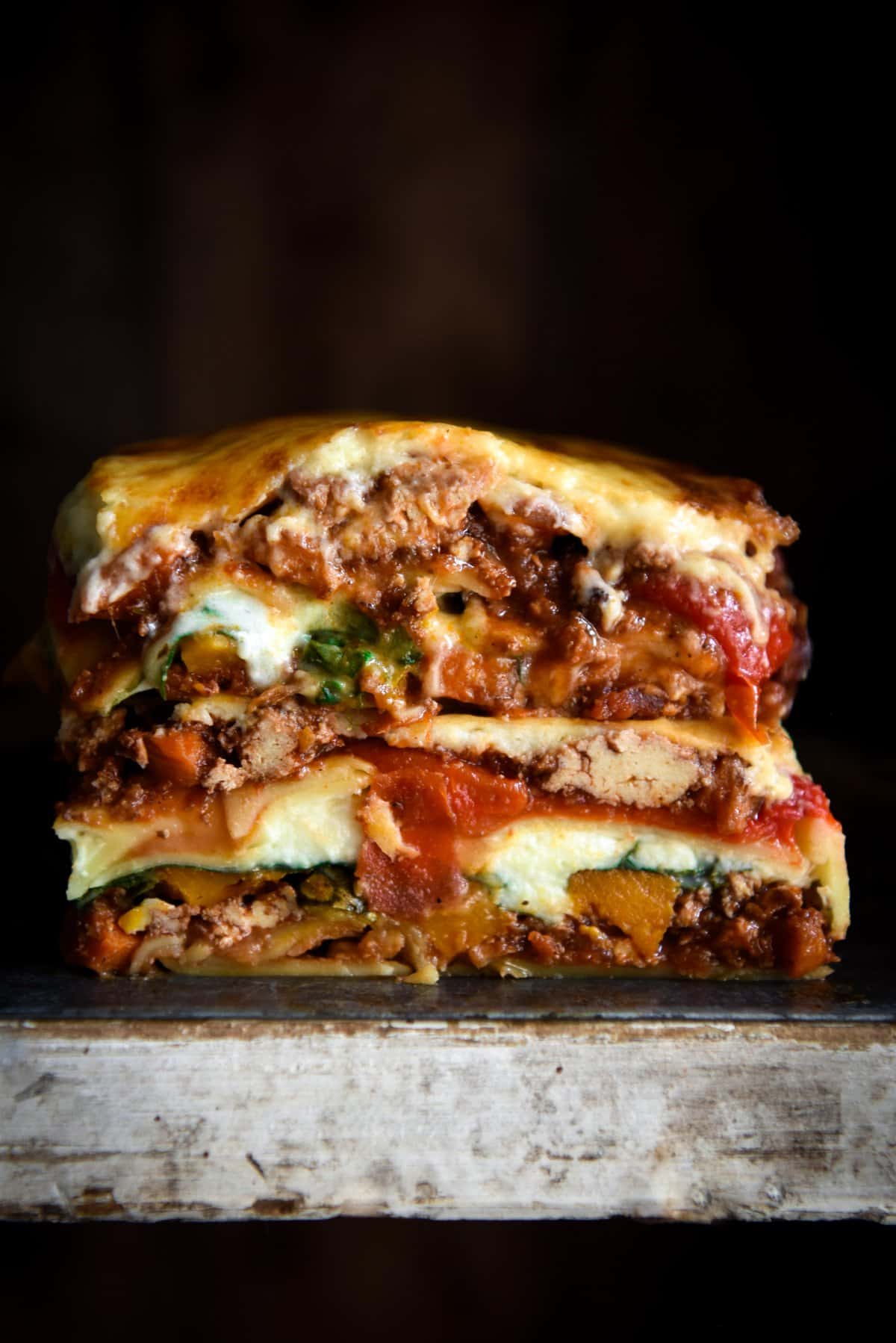
Do I need a pasta machine for these lasagne sheets?
No, you don’t! I find this pasta is easy to roll thinly without the need for a machine. In fact, it tears less often than if you had to feed it through a machine. It does involve some elbow grease to get the pasta to the right length, width and thinness, but that’s a given.
Tips for your gluten free lasagne sheets
The first tip goes without saying: make sure your scalded flour is cooled before you add the eggs. I find 20 minutes is plenty of time. If you mix boiling water and eggs, you’ll end up with a scrambled mess.
With that said, don’t skip the scald! It is super important in developing elasticity in your dough. The psyllium husk, scald and eggs work in tandem to create a pasta dough with strength and one that is easy to roll out.
Personally, I like to cut the sheets to perfectly match my baking dish. This saves having to arrange them neatly to cover the fillings as you assemble the lasagne. I also like to poke 6 or so air holes in each lasagne sheet to allow any excess air to escape.
The bottom of the tin really needs to have bechamel or mince applied in a thin layer before adding the first sheet of lasagne. This gives it something to cook in. I found that laying a lasagne sheet straight on the base resulted in a dry and leathery lasagne sheet.
I find these lasagne sheets puff up as they cook and then drop back as they cool. Just something to be aware of! They are best suited a full bodied lasagne such as a meat or ‘meat’ based one. I used them in a kale pesto lasagne and it worked just the same but looked a little ugly.
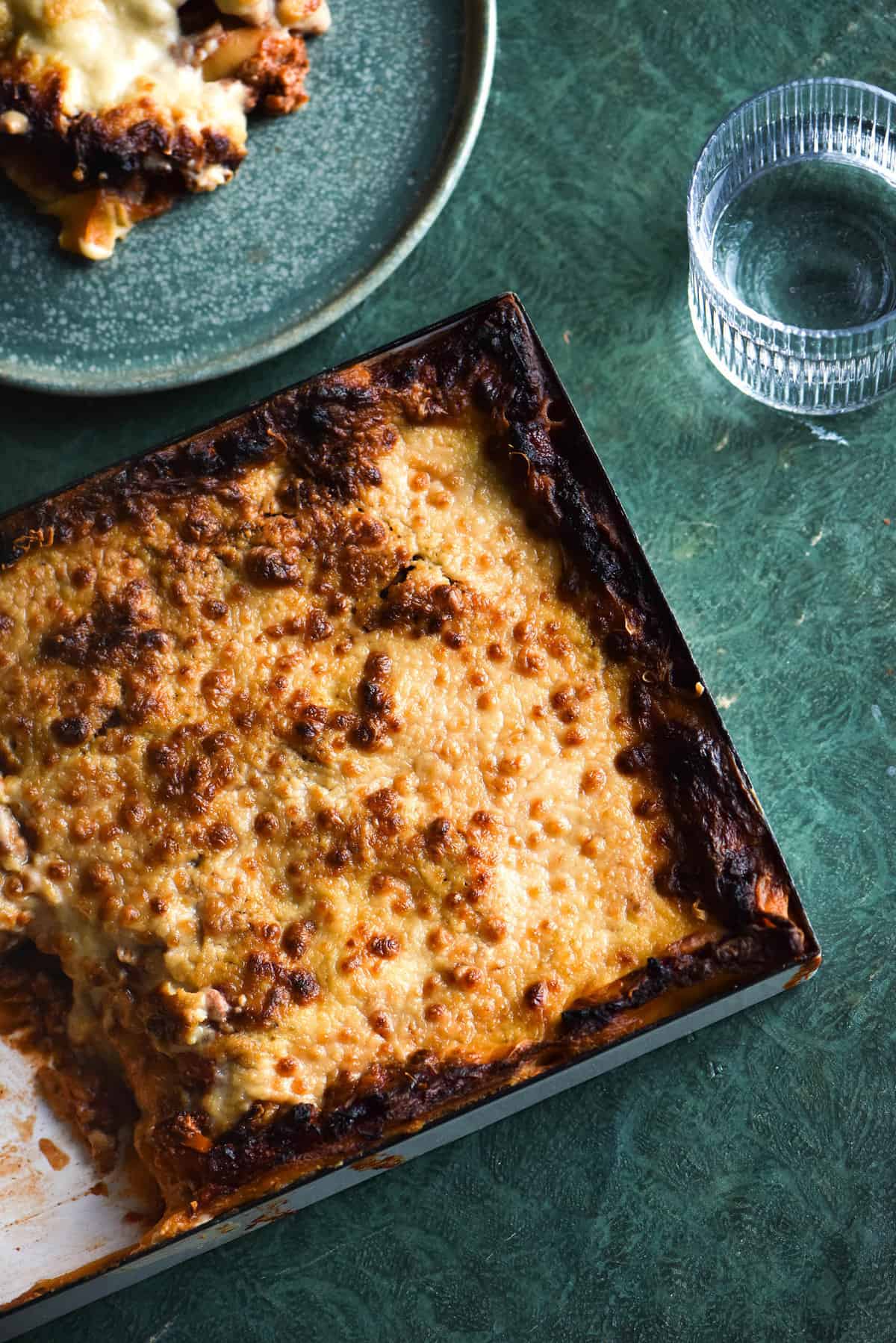
Rolling out your lasagne sheets
Rolling the lasagne sheets is not a particularly complicated process. All you need is some tapioca flour, a sufficiently dry dough, a bit of elbow grease and some patience.
It only takes about 20 minutes to roll all 5/6 sheets of pasta out. I prefer to roll them as I assemble the lasagne, but you can roll them all out before you assemble too.
I like to roll the dough out to slightly larger than my baking dish, then trim the scraggly edges with a non serrated knife. The scraggly edges are often floury and dry and will be unpleasant once cooked, so it’s better to remove them.
With that said, you can easily restore end pieces by sprinkling some water on top before kneading them back to health. The added water will compensate for the tapioca flour added during the rolling process. It will also help restore drier pieces of pasta that have been sitting on the bench as you roll.
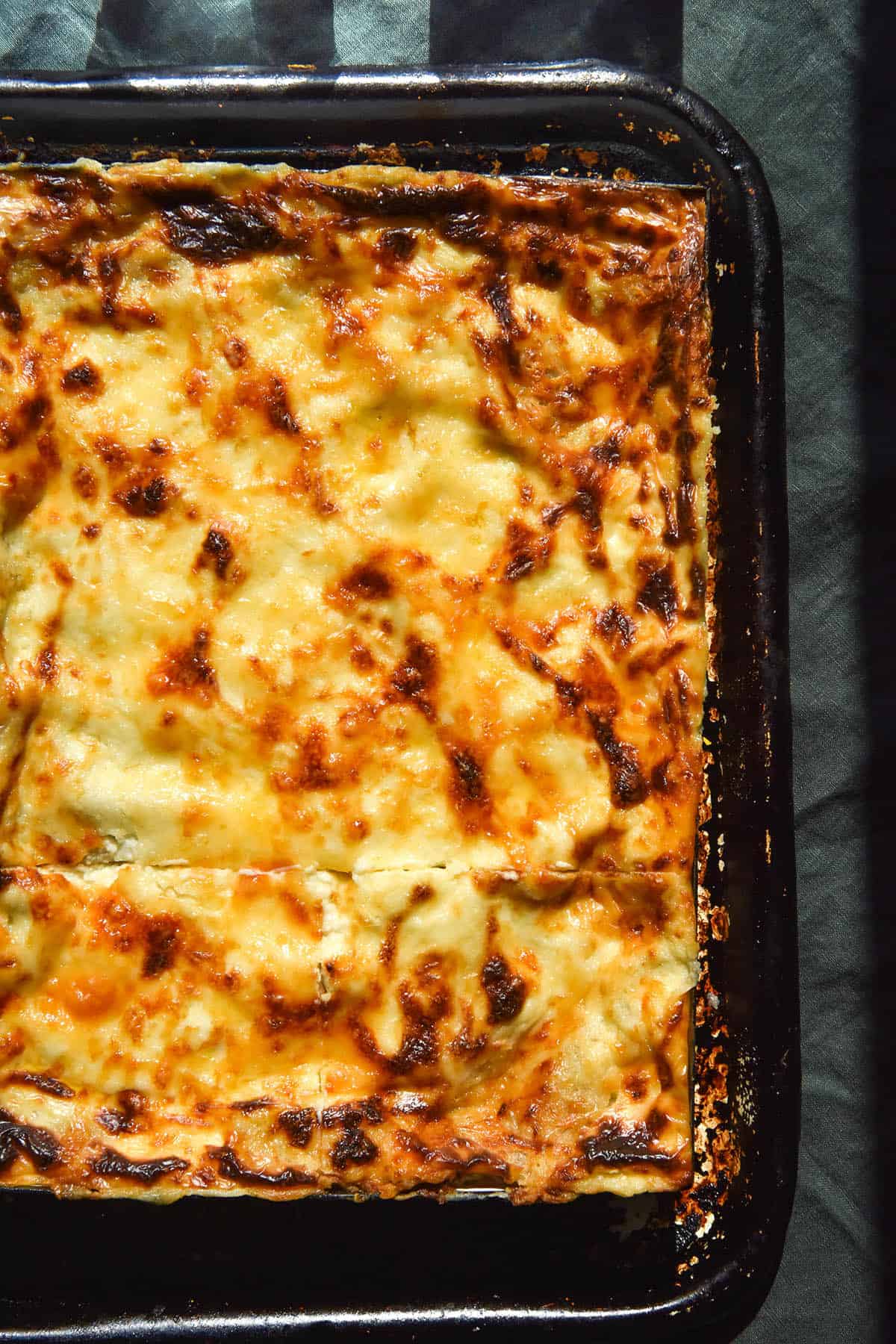
More gluten free recipes
- Gluten free, vegan and low FODMAP lasagne
- Low FODMAP vegetarian lasagne
- Gluten free egg noodles
- Easy low FODMAP pasta
- Gluten free beetroot pasta dough
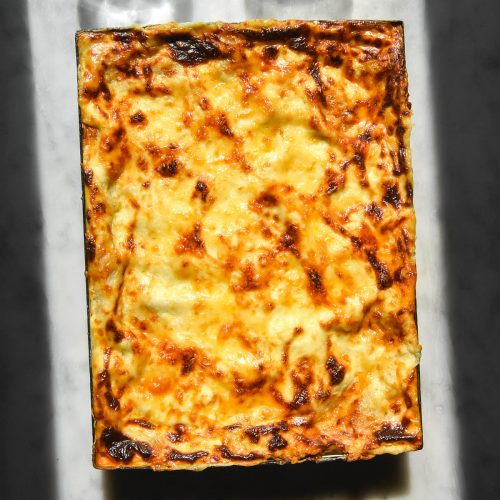
Gluten free lasagne sheets (no xanthan gum)
Ingredients
- 300 g fine white rice flour
- 75 g tapioca flour
- 20 g psyllium husk powder
- 5-7 g fine salt optional
- 150 g boiling water
- 3 extra-large eggs 45-55g per egg, weighed out of shell
- Plenty of extra tapioca flour for rolling out the pasta
Instructions
- Combine the dry ingredients in a large mixing bowl. Pour over the boiling water, then set aside for 20 minutes for the dough to cool.
- Once sufficiently cooled, mix in the eggs. Stir the dough as much as you can, then tip it out onto a clean dry bench. There will likely be lots of dry bits and errant flour. Continue to knead the dough until it comes together in a smooth ball with no dry flour bits. It should be easy to handle – not dry and not wet. If it isn’t the right texture, make amendments (add a small amount of water or flour until you reach the described consistency).
- Liberally flour your bench with tapioca flour and divide the dough in 5 or 6 equal sized balls. Cover all but one.
- Use a rolling pin to roll the dough out into the shape of your baking dish. Take time to roll it really thinly or it will be unpleasant to eat.
- Trim the scraggly edges to ensure the rectangles are the perfect shape for your baking dish. The scraggly edges will also be unpleasant to eat. You can restore them by kneading in small splashes of water until you reach the desired consistency.
- Assemble your lasagne using the lasagne sheets. I like to poke 6 or so small knife holes in the dough to allow air to escape. I recommend making these sheets when you need to use them.
Notes
- I haven’t tested freezing and defrosting raw lasagne sheets. I suspect it would be too much hassle as you would need to lay them all flat and place them on kitchen towel or clean tea towels to soak up any excess liquid.
- The sheets puff up and deflate as they cook. They are best used for a sturdy lasagne using beef mince or vegetarian mince.
- Read notes in the body of the post for substitution options and suggestions.

Hi,
When you say it makes 6 sheets, are they full sheets the size of your baking tray, rather than the little ones you get in a box that you would need multiple of for a layer? Thanks!
Hi Saz! Yes, 5 or 6 full size sheets. At the top of the recipe you will notice it says ’30cm x 22cm rectangular lasagne sheets’ so if your baking dish is smaller or larger you might get a different amount 🙂
Hi!
Do you need to cook these in boiling water before assembling in the lasagne (like you would with regular homemade pasta sheets)? Thanks
Hi Dom, no need to boil them! Just roll them out and you’re good to go 🙂